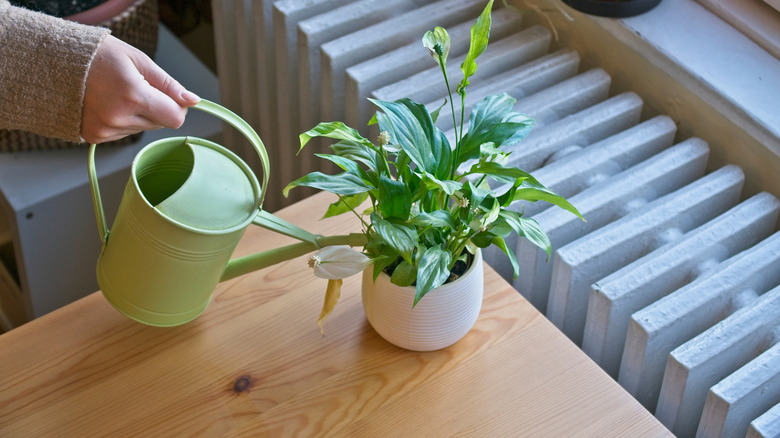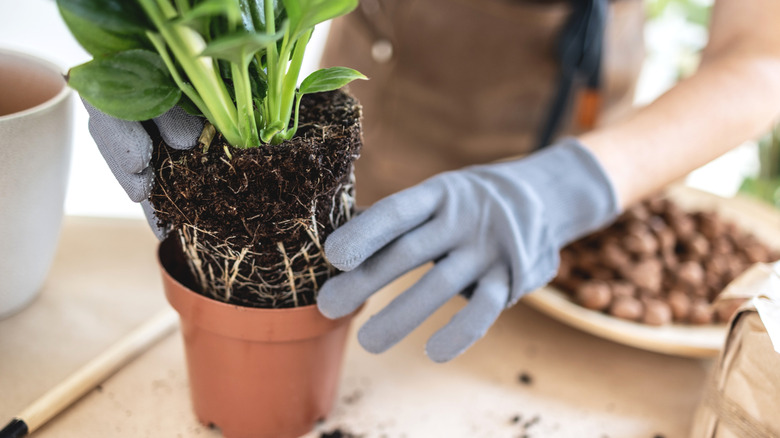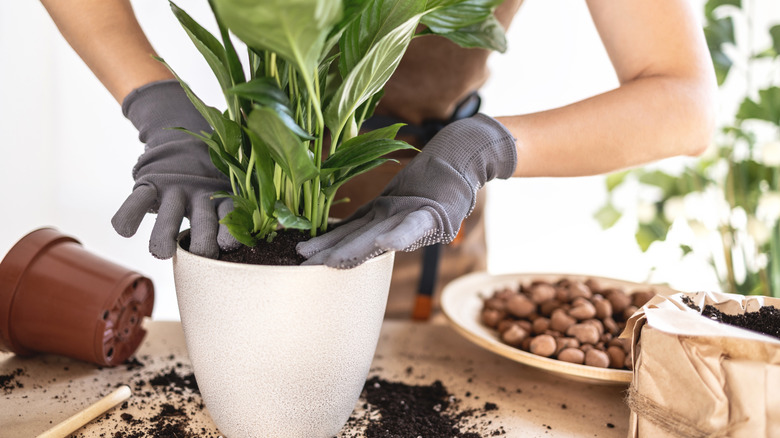If You're Having To Water A Peace Lily Too Often, There's An Easy Fix
You just watered your peace lily plant (Spathiphyllum), so why is its soil bone-dry again two days later? If you're constantly filling up your watering can to keep your tropical friend hydrated, the plant might not be thirstier than usual — its home might be too small. Peace lilies, which are native to the forest floors of the tropics and are only naturally found outdoors in warm areas like USDA Hardiness Zones 11 and 12, have a clever way of telling you they're ready for a new pot. This is one of the important hacks to help your peace lilies fluorish — knowing how to recognize your plant needs a repotting, not just more water.
When you notice that the soil is drying out faster than it used to, it means the roots have used up all the space, and there isn't enough potting mix left to hold on to moisture. The fix is a bigger pot. Smaller containers lose moisture quickly, but a larger one holds more soil, which in turn holds water for a longer period. Just be sure that whatever container you choose has a drainage hole in the bottom. This lets any extra water run out, which is important for keeping the soil from getting soggy.
Recognizing the signs of a thirsty, overgrown peace lily plant
The need for frequent watering is one of the obvious signs that a peace lily has become rootbound. When a plant reaches this state, the roots have fully filled and coiled around the inside of the container, with very little soil left. The plant then uses up the small amount of moisture that's in the soil almost immediately, which is why the soil is dry so soon after watering. To confirm your suspicion, you can gently slide your plant out of its pot and check the root ball. If you see a dense, tightly wound mass of white roots, or if the roots are growing in circles or poking out of the drainage holes, it's time to move up in size.
Other clues that a peace lily needs to be repotted are the plant wilting between waterings or a lack of new, healthy growth. This wilting is often the first thing people notice, which can lead to questions about the best method for watering peace lilies, but the issue may actually be the pot. While young peace lilies may sometimes need repotting every four to six months due to their quick growth, mature plants are typically comfortable in their pot for two to three years. Paying attention to these signs from your plant is the best way to know when they need to be moved into a new container.
How to choose the right pot for your peace lily
To maintain a healthy balance of soil moisture and to prevent overwatering, the new pot should be only 1 to 2 inches larger in diameter than the old one. Getting a pot that's too large can cause it to hold too much water, which may slow down the drying process and lead to root rot. When you do repot, it's best to replace all of the soil. Use a loose, well-draining houseplant potting mix. This type of soil will hold on to moisture while still letting the roots breathe . Choosing the right size pot is important to managing how often to water a peace lily plant.
The ideal time to repot is during the spring. Make sure you loosen any tightly wound roots and remove any soft, mushy, or damaged roots before transplanting. After it's in its new pot, water the plant until you see it coming out of the drainage holes, then put the peace lily in a shady spot for a short time to help it recover from the experience. This gives your plant the space it needs to grow and keeps you from having to water it so often.


